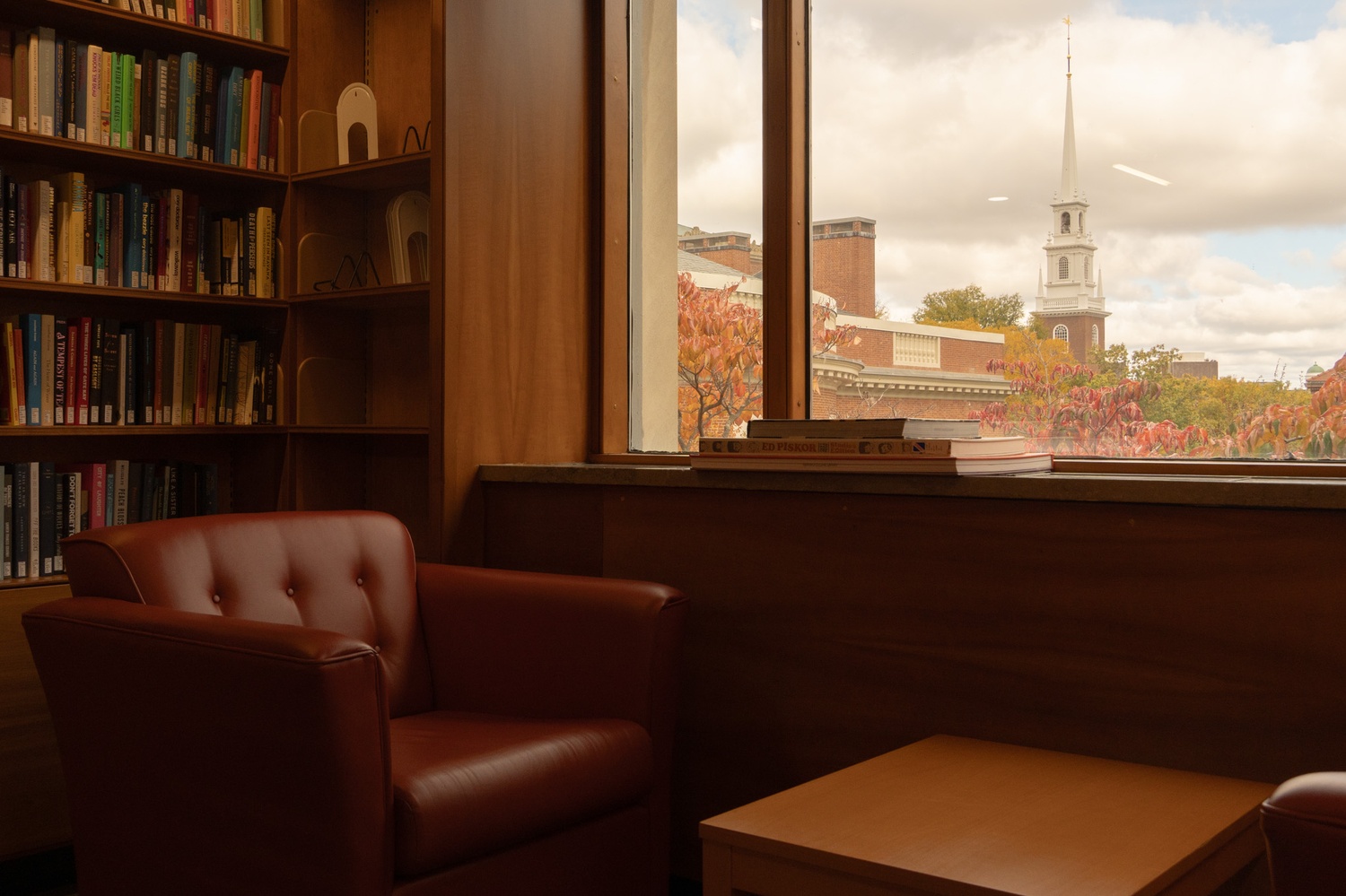Farnsworth, the Hidden Gem of Lamont
One afternoon, we found ourselves wandering into the far depths of Lamont Library, to a small cove lined with shelves of worn paperbacks and glittery hardcovers. It stirred within us an unexpected sense of nostalgia.
We’ve been reading for pleasure for as far back as we can remember — from Rick Riordan’s “Percy Jackson” to Erin Hunter’s “Warriors” series, it seems that we’ve lost hours to stories that felt like our entire world. So, stumbling upon the Henry Weston Farnsworth Room felt like coming home.
Sitting on the third floor, this room is home to what Harvard Library’s website describes as an “eclectic collection of leisure reading.” Here, familiar titles like Veronica Roth’s “Divergent” or Stephenie Meyer’s “Twilight” sit next to the complete “Bridgerton” collection and a half-dozen thick volumes of Marvel’s “Avengers” comics.
In the shadow of Widener’s dense textbooks and philosophical essays, and Houghton’s Shakespeare folios, this corner of Lamont offers something different — the permission to read for fun.
***
The reading room is named for Henry Weston Farnsworth, Class of 1912, though he was far from a model Harvard student. Farnsworth often neglected his coursework, made no academic record, and even took a spontaneous leave of absence from his studies to travel the world: he tried to become a writer in London, took up sailing in Australia, and caught glimpses of Italy on the way.
Despite his disregard for grades and structure, he was a voracious reader who devoured Tolstoy, Dostoevsky, and Byron with a passion and enjoyed the independent study of French, Slavic, and Italian literature, among others.
Upon graduating Harvard, Farnsworth volunteered to fight in World War I as a member of the French Foreign Legion, where he was killed in 1915. His family donated money to fund a collection of “leisure reading material — either things we believe undergraduates would enjoy or items that reflect what Henry Farnsworth himself would have enjoyed,” writes librarian Sarah Hoke in an email to The Crimson. The room — located in Widener until 1949 — was named in Farnsworth’s honor.
Over the decades, the composition of the Farnsworth Room has changed alongside Harvard.“We see a large number of requests for content to use as part of course work that historically might have fallen into that leisure category,” Hoke, who curates the Farnsworth Room, writes.
Though the room’s makeup has changed, its mission never has. Hoke adds that the core concept is “that these materials are ideally things someone would pick up for the joy of reading, rather than as a due diligence for class” — and that this mission “still stands true.”
Hoke admits that defining leisure reading is “a bit of a guessing game sometimes,” noting that the room’s curators use a variety of sources — including bestseller lists like that of the New York Times Book Review, student and librarian recommendations, and books that are popular on social media — to inform their selection. Indeed, the collection includes popular “Booktok” titles like Colleen Hoover’s “It Ends with Us” and Rebecca Yarros’ “Fourth Wing.”
“For the collection itself, we encourage students to submit a purchase request at any time if there is anything they would like to have added,” Hoke writes. Additionally, students have the opportunity to leave suggestions on slips of paper in a box by the room’s entrance.
***
Farnsworth was by no means the perfect Harvard student – his father remarked that he “had no definite plan beyond the desire to test his own powers.” Farnsworth was unconventional, sure, but he embodied the quintessential Harvard student: somebody with a deep thirst for learning and the courage to explore deeper.
Around campus, students turn to Lamont when they need to “lock in” on a paper, p-set, or reading. It’s ironic, then, that the Farnsworth Room, a haven designed for indulgence, is located here.
We’ve lamented for months how we, like Farnsworth, were voracious readers before coming to Harvard — yet now we can’t remember the last time we read something purely for fun, or the last time it didn’t cross our minds that we could be doing something “more productive.”
Lately, it seems as though we’ve made it a habit to push our “leisure” curiosities and enjoyment to the margins in favor of productivity. But the very essence of this room, and its namesake, defies this.
In a culture known for “serious” academics, this room stands in stark contrast. At Harvard, where reading so often feels like a means to an end, the Henry Farnsworth Room dares to offer us something more: reading as an end in itself.



